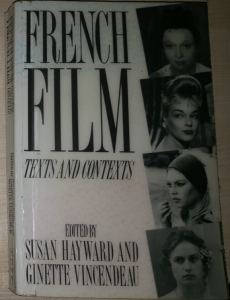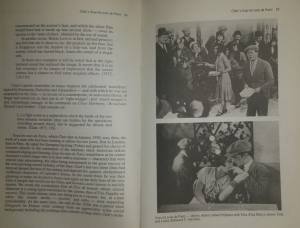Sous les toits de Paris/ Under the Roofs of Paris
Sound in French cinema was not immediate and audience members were not impressed when it was first introduced. In October 1928 the first French sound film was released and was described as a ‘disappointment’ among the public, however 3 months later film-goers warmed up the idea and responded well to a ‘few sentences’ being said in a Al Jolson film. French companies although highly innovative were behind in comparison to America and their production of sound films, in 1929 there were only 8 french sound productions/co-productions. They had new techniques of mixing American sounds systems with German techniques and because of this eventually started to become competition to the American and German industries.
René Clair, the director for ‘Sous les toits de Paris’ was 30 years old when the public started to have an overwhelming new love for the talkies. Starting off as a actor, René Clair eventually became an international famous auteur-director and made an ‘avant garde short’, six silent feature films and more recently 2 adaptations of vaudeville plays by Eugène Labiche, ‘Un Chapeau de pail d’Italie’ and Marc Michels ‘Les Deux timides’. Over the course of these 5 years he had well established himself as of the ‘few genuine auteurs of the new generation filmmakers’ and was known for having a idiosyncratic style and certain preferences to conditions when making his films.
Clip Analysis
The clip that we chose to analyse starts at 00.55.33 and ends at 00.59.25. This scene shows Albert arranging and setting up the house with flowers, to surprise Pola. It starts with a pleasant music in the background, where he is happily decorating everything. Then we can hear a knock on the door, over the music. Thus the music comes to a stop and Albert asks, “Who is it?”. When the detectives say “Go get the locksmith”, the volume is decreased to give the illusion of them talking behind the closed door. An intense music starts to play in the background, when Albert realises that he is in trouble. Further in the scene, when Albert shakes the bag, some metallic sound over the music is played, which helps to give an idea about what is in the bag. We can even notice the glass breaking sound, when he hits the window with the bag. These type of small sound effects has been well used in this movie, to make the audience engage and understand the story easily.
Throughout this scene, until the detectives opens the bag, we are left with the music and sound effects. So, there isn’t a single dialogue in this entire two mins and thirty seconds. This is because that these movies are still mostly based on the silent movie format. Thus we get shots where the detectives asking for the keys without any dialogue. The dialogues are only used when it is necessary. This can be related to the inter-titles used in the silent movies. Overall, it is certain that this movie replaced dialogues instead of inter-titles to get the point across, but at the same time, it also experimented with lots of sound effects to give life to it.
Qualities of Sound
In this extract from ‘Sous Les Toits de Paris’, the quality of sound is remarkably different from previous silent films. In fact, we notice that instrumental music is combined with sound effects and dialogue, which was quite new for that time. Speech and music are employed here as a mode of expression where as before it was mostly music, which shows the improvement in the quality of sound and the development of new techniques. Moreover, whenever there is a dialogue, a white noise is clearly audible in the background. This shows the technology that they had that in the time, which affects the sound quality that we are used to.
Relation between Sounds and Images
Being made in 1930, Rene Clair’s Sous let Toits de Paris was one of the first ever feature length ‘talkies’ to be made and as a result the relationship  between sound and image is evidently not as refined or perfect as later sources. An example of this is how in the start of Sous Les Toits de Paris the film commences as a silent film with music in the background as to not produce a dramatically new change to cinema and lose the audience. Another way in which the relationship between sound and image falls short is as the sound was added other the top of the footage for a large majority of the film. As a result not all the audio is in sync with the visual – this can be seen when the lead protagonist smashes a set of window panes yet the noise of the smash doesnt follow for a good few seconds. This takes away realism from the film and makes the effect of the audio less impressive. Yet these small milestones in the 1930s are the reason we have a realistic sync of audio in modern cinema.
between sound and image is evidently not as refined or perfect as later sources. An example of this is how in the start of Sous Les Toits de Paris the film commences as a silent film with music in the background as to not produce a dramatically new change to cinema and lose the audience. Another way in which the relationship between sound and image falls short is as the sound was added other the top of the footage for a large majority of the film. As a result not all the audio is in sync with the visual – this can be seen when the lead protagonist smashes a set of window panes yet the noise of the smash doesnt follow for a good few seconds. This takes away realism from the film and makes the effect of the audio less impressive. Yet these small milestones in the 1930s are the reason we have a realistic sync of audio in modern cinema.


This is a very impressive and comprehensive post! Excellent, creative use of images, videos and gifs to illustrate your points.
A minor criticism is that the writing is a little uneven at times and not entirely cohesive from section to section, but overall the group’s contextualisation of the advent of sound in French cinema is excellent. You succeed in balancing detailed industrial analysis of the French film industry with skilful filmic analysis of key scenes.
Like you, I find the use of sound in Sous les Toits de Paris to be fascinating and it really allows us to think about the relation between sound and images generally in cinema. This is especially true when we take into account what we would now regard as the film’s sonic imperfections, which draw attention to sound itself. Do you think we take sound for granted as modern-day viewers?